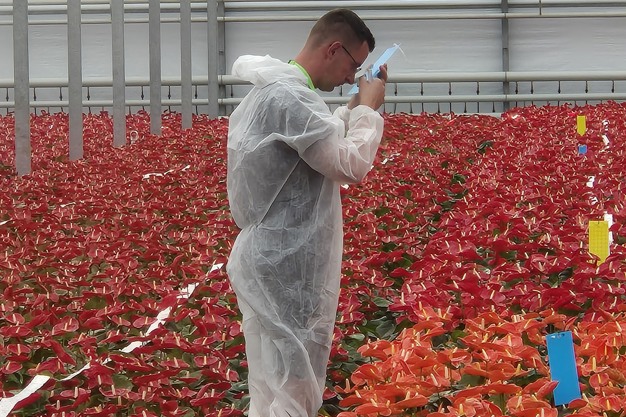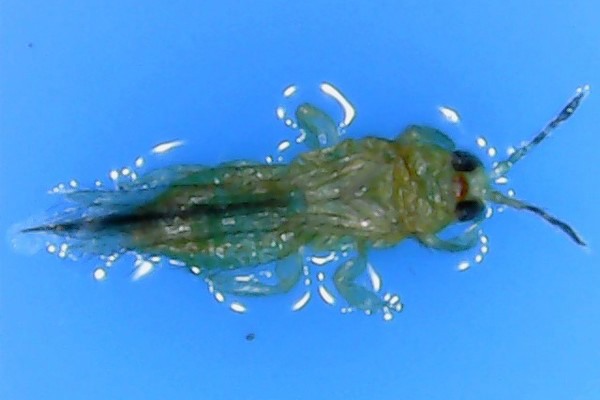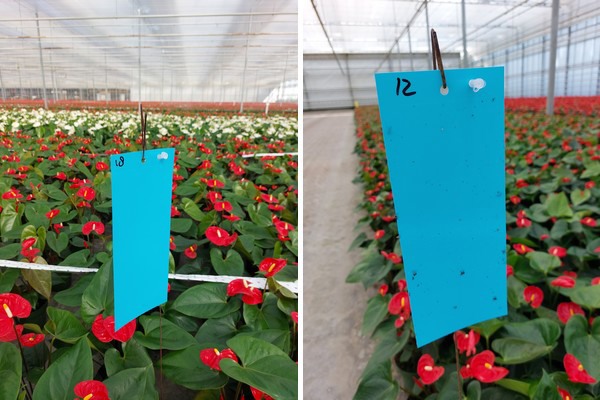Based on degree days, it is possible to calculate when the first thrips pupae will hatch outside. Over the past two weeks, this has happened outside in the field in The Netherlands. However, thrips also appear to be more active indoors in winter than first thought. When monitoring, HortiPro regularly sees adults in the field anyway.
In the greenhouse, thrips are often present all year round anyway. Reason for more and more growers to keep a close eye on pest development with the help of sticky traps and HortiPro's pheromone PheroThrip 2.0.
"We encounter many different species of thrips under glass," shares Lennart Simonse on behalf of the pheromone's supplier. The consultant counts the catch on sticky traps at growers' premises. After a dark spring in The Netherlands, thrips pressure in many greenhouses is lower than last year. "The difference with this time last year is big," he says. It is therefore important to monitor the population closely and, if necessary, control thrips in time.

Lennart checks a sticky trap between potted anthuriums. PheroThrip 2.0 allows growers to monitor thrips.
Intensive thrips monitoring
Knowledge of thrips development, indoors and outdoors, is increasing every year. For about four years now, HortiPro has been working on PheroThrip 2.0, in which (intensive) monitoring is central to the thrips approach.
Among others, potted anthurium grower Leon Breugem and cut hydrangea grower André Vollering (link to article in Dutch) were early adopters. The growers use the knowledge from the weekly monitoring to act in time. What was noticed at the time was that thrips were actively present in the greenhouse much earlier than first thought. And also in larger numbers.

This is what a caught thrips looks like, magnified for clarity
Timely intervention
Even with the late start of thrips development outside and the pest pressure in greenhouses being limited, Lennart knows of examples where intervention with a plant protection product was needed anyway this spring. "By intervening in time with a (green) pesticide, the thrips pressure can be brought down again. Then the biological control agents can further control the thrips."
With timely insight into thrips development, growers can also intervene in time, ultimately allowing them to grow as much as possible organically. Several years later, that is still how it works. The number of authorised crop protection products is still decreasing in The Netherlands. Meanwhile, growers invest in insect netting, but not all mesh sizes keep out thrips. The little critters are not easy to catch, but they do appear to be eager to get hold of HortiPro's blue sticky traps with thrips pheromone, Lennart sees during counts in the greenhouse time and again.

HortiPro works with blue sticky traps
Catching more thrips
For monitoring purposes, HortiPro uses blue sticky traps containing the PheroThrip pheromone. Growers themselves sometimes also use regular yellow sticky traps. "We see in counts that we sometimes catch factor ten more with our blue sticky traps with pheromone compared to the yellow sticky traps. An additional advantage is that thrips stand out better against a blue sticky trap. That helps in counting and distinguishing the species." And thus helps growers gain insights on what to do to keep thrips pressure low.
For more information:
Lennart Simonse
HortiPro
[email protected]
www.hortipro.com
